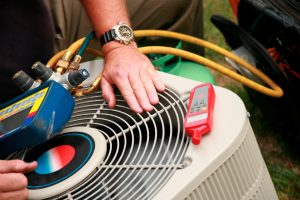 The principles of air conditioning are reasonably simple, and new units still do the same work that old ones did fifty years ago. Granted, there have been some innovations along the way. Air conditioner used to be quite expensive and many homes couldn’t afford it. (Movie theaters used to advertise air conditioning as a way of getting people to buy tickets.) Innovations in size and efficiency have made it possible for every home to afford an air conditioner, something that wouldn’t have been possible not so long ago.
The principles of air conditioning are reasonably simple, and new units still do the same work that old ones did fifty years ago. Granted, there have been some innovations along the way. Air conditioner used to be quite expensive and many homes couldn’t afford it. (Movie theaters used to advertise air conditioning as a way of getting people to buy tickets.) Innovations in size and efficiency have made it possible for every home to afford an air conditioner, something that wouldn’t have been possible not so long ago.
Every technology advances, and innovations in HVAC systems have advanced in leaps and bounds as well. Some of the directly affect the air conditioner itself. Others are secondary systems which can be attached to your HVAC system and improve its performance. Here’s a short list of 3 HVAC innovations on the market today that you can add without making significant changes to the system itself.
Thermostats
Thermostats are designed to last a long time, and because they contain few moving parts, they can go for decades of more before needing to be replaced. That, however, means that you can miss some of the big advantage in thermostat technology that have come of late. For example, smart thermostats can analyze your cooling habits and make little adjustments to maximize efficiency. Other thermostats possess WFfi connections, which allow you to control them and program them via an app on your phone.
Zone Control Systems
Zone control systems are essentially a series of valves or shutters, placed at key positions throughout the ducts in your air conditioner system. They allow you to adjust and control the flow of air to different sections of your home: setting different temperatures in different rooms to cater to individual tastes. They also allow you to turn off the air in unused portions of the home while still running the air in portions of the home you are. The results can lower your monthly cooling bills tremendously, as well as reducing strain on the air conditioner as a whole.
Energy Evaluations
An energy evaluation gives a trained technician a chance to look your home over and determine if it could use improvements to help it better retain energy. In some ways, that task hasn’t check: a lack of insulation, for instance, isn’t hard to determine, nor is spotting cracks under doors and around windows. (Such cracks can be sealed by weather-stripping easily purchased at any hardware store.)
But to really get a reliable estimate of where you home is losing energy and what to do about it, we can use a whole array of new tools to do the job. Thermal imaging, for instance, can spot the presence of hot spots or cold spots in your home, while radiant heating systems installed in your attic can help you make more efficient use of your HVAC system.
For HVAC system services of all varieties in Twin Falls ID, call the friendly professionals at Evans Plumbing, Inc. today to set up an appointment!


